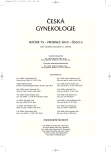Possibilities of diagnostics yeasts in gynecologist patients
Authors:
V. Matula 1; J. Kestřánek 1; V. Buchta 2; M. Broďák 3; J. Špaček 1
Authors‘ workplace:
Klinika porodnictví a gynekologie, FN a LF UK v Hradci Králové, přednosta doc. MUDr. J. Tošner, CSc.
1; Ústav klinické mikrobiologie, FN a LF UK v Hradci Králové, přednosta doc. RNDr. V. Buchta, CSc.
2; Urologická klinika, FN a LF UK v Hradci Králové, přednosta MUDr. M. Broďák, Ph. D.
3
Published in:
Ceska Gynekol 2010; 75(6): 547-552
Overview
Problem of mycoses in gynecology is considered very frequent and yeasts are traditionally described as most common cause of vulvovaginal disorders. While acute disorders can be promptly cured in most cases, there is a group of women suffering from those repeatedly. Following article refers to a group of patients in long-term follow-up and shows realistic possibilities of diagnostics, available to out-patient gynecologist. Preliminary results of our pilot project do not confirm yeasts have to be the primary etiologic factor, nevertheless it is logical to be in search of them in these patients.
Key words:
candida, diagnosis, microscopy, cultivation, tests.
Sources
1. Andrioli, JL., Oliveira, GS., Barreto, CS., et al. Frequency of yeasts in vaginal fluid of women with and without clinical suspicion of vulvovaginal candidiasis. Rev Bras Ginecol Obstet, 2009, 3, 6, p. 300-304.
2. Beigi, RH., Meyn, LA., Moore, DM., et al. Vaginal yeast colonization in nonpregnant women: a longitudinal study. Obstet Gynecol, 2004, 104(5 Pt1), p. 926-930.
3. Buchta, V., Špaček, J., Jílek, P. Mykotické infekce ženského genitálu I. Epidemiologie a mikrobiologie. Gynekolog, 1997, 2, 2, s. 67-70.
4. Buchta, V., Špaček, J. Mikrobiologické nálezy u pacientek s rekurentní vulvovaginální kandidózou ve Fakultní nemocnici Hradec Králové v letech 1995-2002. Čes Gynek, 2004, 69, 1, s. 7‑14.
5. Casanova, RG., Narcio Reyes, LE., Ortiz Ibarra, FJ., et al. Usefulness of fresh wet Mount examination in the diagnosis of vaginal candidiasis. Ginecol Obstet Mex, 1997, 65, p. p. 87-91.
6. Correa, PR., David, PR., Peres, NP., et al. Phenotypic characterization of yeasts isolated from the vaginal mucosa of adult women. Rev Bras Ginecol Obstet, 2009, 31, 4, p. 177-181.
7. Corsello, S., Spinillo, A., Osnengo, G., et al. An epidemiologic survey of vulvovaginal candidiasis in Italy. Eur J Obset Gynecol Reprod Biol, 2003, 110, 1, p. 66-72.
8. Dan, M., Leshem, Y., Yeshaya, A. Performance of rapid yeast test in detecting Candida spp. in the vagina. Diagn Microbiol Infect Dis, 2010, 67, 1, p. 52-55.
9. Esim Buyukbayrak, E., Kars, B., Karsidag, AY., et al. Diagnosis of vulvovaginitis: comparison of clinical and microbiological diagnosis. Arch Gynecol Obstet, 2010. Dostupný z www.ncbi.nlm.nih.gov/pubmed/20461391.
10. Evans, EG. Diagnostic laboratory techniques in vaginal candidosis. Br J Clin Pract, 1990, 71, Suppl, p. 70-72.
11. Fan, S., Liu, XP., Li, JW. Clinical characteristics of vulvovaginal candidiasis and antifungal susceptibilities of Candida species isolates among patients in southern China from 2003 to 2006. J Obstet Gynaecol Res, 2008, 34, 4, p. 561-566.
12. Fan, SR., Liu, XP. In vitro fluconazole and nystatin susceptibility and clinical outcome in complicated vulvovaginal candidosis. Mycoses 2010. Dostupný z www.ncbi.nlm.nih.gov/ pubmed/20406393.
13. Heinsbroek, SE., Brown, GD., Gordon, S. Dectin-1 escape by fungal dimorphism. Trends Immunol, 2005, 26, 7, p. 352-354.
14. Chatwani, AJ., Mehta, R., Hassan, S., et al. Rapid testing for vaginal yeast detection: a prospective sutdy. Am J Obstet Gynecol, 2007, 196, 4, p. 309.
15. Lascar, RM., Devakumar, H., Jungman, E., et al. Is vaginal microscopy an essential tool for the management of women presenting with vaginal discharge? Int J STD AIDS, 2008, 19, 12, p. 859-860.
16. Maccato, ML., Kaufman, RH. Fungal vulvovaginitis. Curr Opin Obstet Gynecol, 1991, 3, 6, p. 849-852.
17. Mardh, PA., Novikova, N., Witkin, SS., et al. Detection of candida by polymerase chain reaction vs microscopy and culture in women diagnosed as recurrent vulvovaginal cases. Int J STD AIDS, 2003, 14, 11, p. 753-756.
18. Mohanty, S., Xess, I., Hasan, F., et al. Prevalence & susceptibility to fluconazol of Candida species causing vulvovaginitis. Indian J Med Res, 2007, 126, 3, p. 216-219.
19. Priestley, CJ., Jones, BM., Dhar, J., Goodwin, L. What is normal vaginal flora? Genitourin Med, 1997, 73, 1, p. 23-28.
20. Saturnino, AC., Sisenado, HA., Pereira, AR., et al. Vulvovaginitis: vaginal pH ganges and associated microflora. Acta Cir Bras, 2005, 20, Suppl. 1, p. 266-299.
21. Sobel, JD. Vulvovaginal candidosis. Lancet, 2007, 369, 9577, p. 1961-1971.
22. Špaček, J., Buchta, V., Jilek, P., et al. Clinical aspects and luteal phase assessment in patiens with recurrent vulvovaginal candidiasis.Eur J Obstet Gynecol Reprod Biol, 2007, 131, 2, p. 198-202.
23. Špaček, J., Buchta, V., Jílek, P., et al. Rekurentní vulvovaginální kandidóza – současný stav a léčebné možnosti. Čes Gynek, 2008, 73, s. 179-184.
24. Van Kessel, K., Assefi, N., Marazzo, J., Eckert, L. Common complementary and alternative therapies for yeast vaginitis and bacterial vaginosis: a systematic review. Obstet Gynecol Surv, 2003, 58, 5, p. 351-358.
25. Zdolsek, B., Hellberg, D., Froman, G., et al. Culture and wet smear microscopy in the diagnosis of low-symptomatic vulvovaginal candidosis. Eur J Obstet Gynecol Reprod Biol, 1995, 58, 1, p. 47-51.
Labels
Paediatric gynaecology Gynaecology and obstetrics Reproduction medicineArticle was published in
Czech Gynaecology

2010 Issue 6
Most read in this issue
- Vulvodynia and the possibility of its management
- Operation procedures in female sterilisation
- Asherman’s syndrome II – therapy, methods of guidance, prevention of readhesion processs, complications and results of therapy
- Nalbuphine at maternal analgesia
